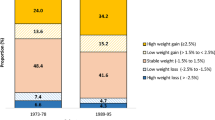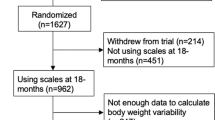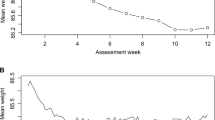Abstract
Objective:
To establish the prevalence of weight change in mid-aged women over a 2-year period, and to assess the relationship between weight change and physical and mental well-being (SF36) in order to begin debate about the need for quantified standards of weight gain.
Design:
Prospective study of weight change and well-being over a 2-year period among mid-aged women participating in a large national survey.
Subjects:
Seven thousand two hundred and seventy women without surgical menopause aged between 45 and 50 years (termed mid-aged), enrolled in the Australian Longitudinal Study on Women's Health.
Measurements:
Weight change (self-reported weight at two time points) and physical and mental well-being (SF-36) explored using linear regression, while adjusting for potential confounders.
Results:
Only half the women maintained their weight within 2.25 kg, and one-third gained more than this amount in a 2-year period. While weight gain (⩾2.25 kg) was negatively associated with physical well-being, both weight loss and weight gain were associated with poorer mental well-being.
Conclusion:
This is the first prospective study using a large, population-based cohort to demonstrate that small changes in weight are associated with changes in well-being in mid-aged Australian women. It provides further evidence of the need for public health messages to specify the actual amount that constitutes weight gain, but further research is needed to establish these standards for the entire population.
This is a preview of subscription content, access via your institution
Access options
Subscribe to this journal
Receive 12 print issues and online access
$259.00 per year
only $21.58 per issue
Buy this article
- Purchase on Springer Link
- Instant access to full article PDF
Prices may be subject to local taxes which are calculated during checkout
Similar content being viewed by others

References
World Health Organisation. Obesity: Preventing and Managing the Global Epidemic. World Health Organisation: Geneva, 2000.
World Health Organisation. Physical status: the use and interpretation of anthropometry Report of a WHO Expert Committee. World Health Organisation: Geneva 1995.
Scottish Intercollegiate Guidelines Network. Obesity in Scotland: Intergrating Prevention with Weight Management. Scottish Intercollegiate Guidelines Network: Scotland, 1996.
St Jeor ST, Brunner RL, Harrington ME, Scott BJ, Daugherty SA, Cutter GR et al. A classification system to evaluate weight maintainers, gainers and losers. J Am Diet Assoc 1997; 97: 481–488.
Ware Jr JE, Sherbourne CD . The MOS 36-item short-form health survey (SF-36). I. Conceptual framework and item selection. Med Care 1992; 30: 473–483.
Brown W, Dobson A, Mishra G . What is a healthy weight for middle aged women? Int J Obes Relat Metab Disord 1998; 22: 520–528.
Larsson U, Karlsson J, Sullivan M . Impact of overweight and obesity on health-related quality of life –Swedish population study. Int J Obes Relat Metab Disord 2002; 26: 417–424.
Coakley E, Kawachi I, Manson J, Speizer F, Willet WC, Colditz GA . Lower levels of physical functioning are associated with higher body weight among middle-aged and older women. Int J Obes Relat Metab Disord 1998; 22: 958–965.
Fine JT, Graham A, Colditz GA, Moseley G, Manson JE, Willett WC et al. A prospective study of weight change and health-related quality of life in women. JAMA 1999; 282: 2136–2142.
Bryson L . The Women's Health Australia project and policy development. Aust J Prim Health 1998; 4: 59–71.
Brown WJ, Bryson L, Byles JE, Dobson A . Women's health Australia: recruitment for a national longitudinal cohort study. In: Manderson L (ed). Australian Women's Health. The Haworth Press Inc.: Melbourne, 1998, pp 23–40.
National Health and Medical Research Council. Acting on Australia's Weight: A Strategic Plan for the Prevention of Overweight and Obesity. Australian Government Publishing Service: Canberra, 1997.
Brown W, Dobson A, Bryson L, Byles JE . Women's health Australia: on the progress of the main cohort studies. J Womens Health Gend Based Med 1999; 8: 681–688.
Department of Primary Industry & Energy, Department of Health and Housing. Rural, Remote and Metropolitan Areas Classification: 1991 Census Edition. Australian Government Publishing Service: Canberra, 1994.
McHornery CA, Ware Jr JE, Lu JF, Sherbourne CD . The MOS 36-item Short-Form Health Survey (SF-36): III. Tests of data quality, scaling assumptions, and reliability across diverse patient groups. Med Care 1994; 32: 40–66.
Mishra G, Schofield M . Norms for the physical and mental health component summary scores of the SF-36 for young, middle-aged and older Australian women. Qual Life Res 1998; 7: 215–220.
Patterson AJ, Brown WJ, Powers JR, Roberts DC . Iron deficiency, general health and fatigue: results from the Australian Longitudinal Study on Women's Health. Qual Life Res 2000; 9: 491–497.
Australian Bureau of Statistics. National Health Survey: 1995 SF-36 Population Norms Australia. Australian Government Publishing Service: Canberra, 1997. pp 14–15, 28–29.
Niedhammer I, Bugel I, Bonenfant S, Goldberg M, Leclerc A . Validity of self-reported weight and height in the French GAZEL cohort. Int J Obes Relat Metab Disord 2000; 24: 1111–1118.
Larson MR . Social desirability and self-reported weight and height. Int J Obes Relat Metab Disord 2000; 24: 663–665.
Willett WC, Stampfer MJ, Bain C, Lipnick R, Speizer FE, Rosner B et al. Cigarette smoking, relative weight and menopause. Am J Epidemiol 1983; 117: 651–658.
Stunkard AJ, Albaum JM . The accuracy of self-reported weights. Am J Clin Nutr 1981; 34: 1593–1599.
Acknowledgements
The Australian Longitudinal Study on Women's Health, which was conceived and developed by groups of inter-disciplinary researchers at the Universities of Newcastle and Queensland, is funded by the Australian Government Department of Health and Ageing. We thank all participants for their valuable contribution to the project.
Author information
Authors and Affiliations
Corresponding author
Additional information
This work was conducted through the Research Centre for Gender and Health at The University of Newcastle.
Rights and permissions
About this article
Cite this article
Williams, L., Young, A. & Brown, W. Weight gained in two years by a population of mid-aged women: how much is too much?. Int J Obes 30, 1229–1233 (2006). https://doi.org/10.1038/sj.ijo.0803262
Received:
Revised:
Accepted:
Published:
Issue Date:
DOI: https://doi.org/10.1038/sj.ijo.0803262
Keywords
This article is cited by
-
The impact of a weight reduction program with and without meal-replacement on health related quality of life in middle-aged obese females
BMC Women's Health (2014)
-
Can a relatively low-intensity intervention by health professionals prevent weight gain in mid-age women? 12-Month outcomes of the 40-Something randomised controlled trial
Nutrition & Diabetes (2014)
-
Bidirectional association between weight change and depression in mid-aged women: a population-based longitudinal study
International Journal of Obesity (2014)
-
Weight Gain, Overweight, and Obesity: Determinants and Health Outcomes from the Australian Longitudinal Study on Women’s Health
Current Obesity Reports (2014)
-
The 40-Something randomized controlled trial to prevent weight gain in mid-age women
BMC Public Health (2013)


